Samsung Galaxy Tab S review: a rival for the iPad?
Samsung’s gone all out to beat Apple’s iPad with a stunning screen, fingerprint scanner and snappy processor
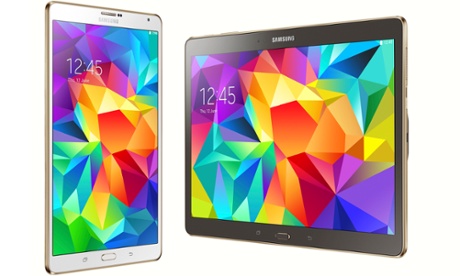 Samsung has thrown everything into its new flagship tablet, but is the Tab S good enough to beat the king of tablets, the iPad? Photograph: Samsung
Samsung has thrown everything into its new flagship tablet, but is the Tab S good enough to beat the king of tablets, the iPad? Photograph: Samsung
The Galaxy Tab S is Samsung’s no-holds-barred attempt to beat Apple and its dominant iPad. With an incredible screen, slim build and snappy processor Korea might finally have something Apple should worry about.
The stakes are high: my understanding is that if this doesn’t sell well against the iPad (which Samsung’s other premium Android tablets haven’t), then the south Korean company is going to stop trying to compete at the top end.
Next year tablets are expected to overtake PCs, according to research firm Gartner, so the time is right for Samsung to attempt to claim a major share of the high-end tablet market.
Thin, light and feeling good
The Tab S looks like any other Samsung tablet, budget or premium. It has a screen, a small bezel, a plastic edge and a plastic back – Samsung hasn’t been known for its mould-breaking design and nothing has changed here.
What has changed is how the tablet feels. It is still plastic but the edge has a metal-infused colouring, which is like a halfway house between metal and plastic – it is smooth and cold like metal, while feeling softer to the touch, like plastic.
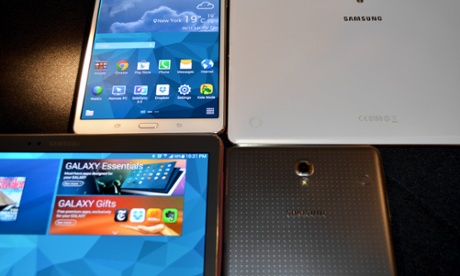 Samsung’s Tab S comes in two colours ‘dazzling white’ and ‘titanium bronze’ or what most people would call brown with dark gold edging Photograph: Samuel Gibbs/The Guardian
Samsung’s Tab S comes in two colours ‘dazzling white’ and ‘titanium bronze’ or what most people would call brown with dark gold edging Photograph: Samuel Gibbs/The Guardian
The back is a dimpled soft-touch plastic like the Galaxy S5 smartphone’s back, and feels nice to touch while providing a sure grip.
The Tab S is also very thin, at 6.6mm thick – thinner than the 7.5mm thick iPad Air, though thicker than Sony’s super-skinny 6.35mm thick Xperia Z2 Tablet. The Tab S is also lighter than the iPad Air, with the 10.5in version weighing 465g (iPad Air 469g) and the 8.4in version weighing 294g (7.9in iPad mini with Retina 331g). Both still feel sturdy and solidly built, with minimal flex or give in the body.
There are stereo speakers along the sides towards the top, so hands won’t block them when it’s held in landscape orientation. They are decent enough, but lack any sort of bass and can be a bit quiet at times.
The tablet’s back sports Samsung’s “Simple Clickers”, which are Samsung’s attempts to mirror the simplicity of fitting cases and other accessories for Apple’s iPad (where its “Smart Cover” attaches with magnets) without infringing on Apple’s patents – or using magnets.
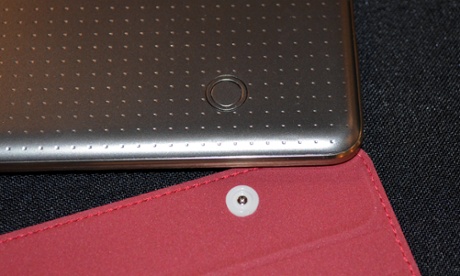 Two small round trap-door like ‘Simple Clickers’ are on the back of the tablet for attaching cases and other accessories. Photograph: Samuel Gibbs/The Guardian
Two small round trap-door like ‘Simple Clickers’ are on the back of the tablet for attaching cases and other accessories. Photograph: Samuel Gibbs/The Guardian
The Clickers are like little spring-loaded trap doors, which you barely notice if not being used, and accept little snap-in buttons. They hold cases in place very securely, but are a little fiddly to get snapped in.
A new standard in screen quality
The Tab S is the first affordable tablet to sport a high-resolution large-size organic LED (OLED). That means that unlike LED tablets such as the iPad, it doesn’t need a backlight, and so can be thinner. The pixels in OLED emit their own light when there’s a voltage, and when “off” (black) don’t draw any power.
The Tab S’s screen is the best I’ve ever seen on a tablet. The blacks are inky, the whites are paper white, the colours vibrant and more true to life than most LCDs. The screen is bright enough to read even in direct sunlight.
Magazines and comics look particularly good, while photos and videos are full of contrast and colour.
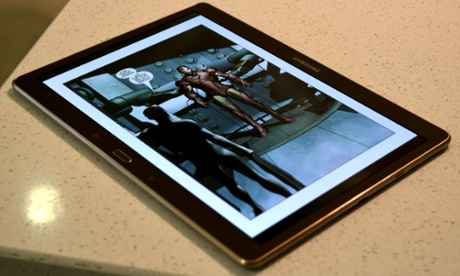 Comics, magazines, books, photos and videos all look particularly good on the Tab S’s stunning AMOLED screen. Photograph: Samuel Gibbs/The Guardian
Comics, magazines, books, photos and videos all look particularly good on the Tab S’s stunning AMOLED screen. Photograph: Samuel Gibbs/The Guardian
Both the 10.5in and 8.4in models have 2,560 x 1,600 pixels, offering 287 pixels per inch (ppi) and 360 ppi respectively; the iPad Air is 264 ppi and iPad mini with Retina is 326 ppi. However, you would be hard-pressed to see the difference in pixel density in person.
Specifications
• Screen: 8.4in or 10.5in WQXGA (2,560 x 1,600) Super AMOLED
• Processor: Samsung Exynos 5 Octa (1.9 GHz quad-core + 1.3GHz quadcore)
• RAM: 3GB of RAM
• Storage: 16GB (microSD slot also available)
• Operating system: Android 4.4 “KitKat”
• Camera: 8MP rear camera, 2.1MP front-facing camera
• Connectivity: Wi-Fi, Bluetooth 4.0 with BLE and GPS (LTE optional)
• Dimensions: 125.6 x 212.8 x 6.6mm / 247.3 x 177.3 x 6.6mm
• Weight: 294g/465g
Stamina to last all day
The Tab S uses Samsung’s own Exynos 5 Octa processor. Technically it has eight processing cores, but only uses four at any one time. It has four “big” processing cores for doing heavy lifting, with four more “little” lower-power processor cores for “lighter” jobs. The aim: to extend battery life.
It feels snappy, for the most part (more on that later), and handles anything you can throw at within apps, sailing untroubled through the most graphically rich games.
I found both Tab S models lasted a good day (about 15 hours) on a single charge under constant usage (constant push email, a few hours’ browsing, perhaps an hour of video) without activating any of the power-saving modes. Even with a power-hungry application like the Assassin’s Creed 4 second-screen app connected to a PS4 the 10.5in tablet lasted a good eight hours.
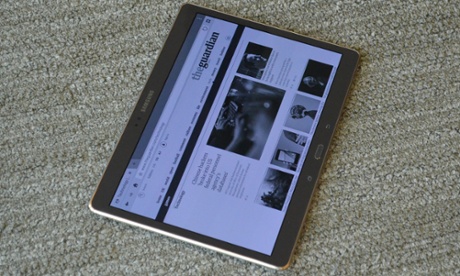 Samsung’s Ultra power saving mode switches the display to greyscale and limits the apps you can use, but extends the standby time of the tablet by dozens of days. Photograph: Samuel Gibbs/The Guardian
Samsung’s Ultra power saving mode switches the display to greyscale and limits the apps you can use, but extends the standby time of the tablet by dozens of days. Photograph: Samuel Gibbs/The Guardian
There are also two power-saving modes. One limits performance to add a couple of hours’ battery life; the other is the “Ultra power saving mode”, which switches the screen to greyscale (saving power through the OLED screen), turns off Wi-Fi and restricts the number of apps that can be used to nine, including Facebook, Twitter, Google+, the calculator, calendar, browser and clock – it should give the tablet around 16 days of standby time from just 20% of battery.
A micro-SD card slot allows storage expansion from the 16GB of built-in space (around 9GB available to the user). An IR blaster on the top can control a TV or other compatible home entertainment equipment.
Modified Android with a few small misses
Software is traditionally where Samsung struggles but the Tab S has the best Samsung software I’ve seen to date. It’s still not great in places. The interface is colourful, if a bit childlike, while its Magazine app which sits at the most left homescreen panel cannot be removed.
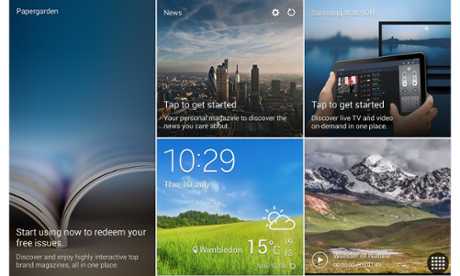 Magazine UI doubles and Flipboard and a Windows 8-style tile interface for the calendar and email apps.
Magazine UI doubles and Flipboard and a Windows 8-style tile interface for the calendar and email apps.
The biggest issue is that Samsung’s software is not very well optimised. Small moments of lag crop up here and there when switching between screens or invoking the keyboard. That absolutely shouldn’t happen, because the underlying hardware is powerful, and apps zip along. With a bit more work Samsung could have smoothed out those bumps, but they won’t bother most people.
Some of Samsung’s software features can be useful, like Multi-window which (as on Microsoft’s Surface) can run two apps side-by-side; others like S Voice can be safely ignored or replaced by apps like Google Now for better functionality.
Samsung bundles a collection of app “gifts” with the Tab S, with three months of Marvel Unlimited and one year of Business Week subscriptions being notable.
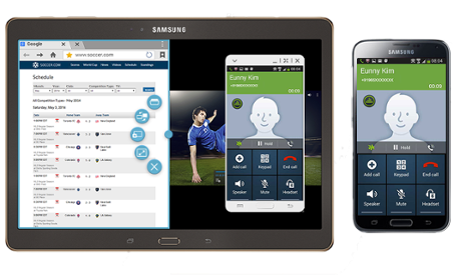 Side-Sync allows mirroring of a Galaxy S5 smartphone on the Tab S including call and messages. Photograph: Samsung
Side-Sync allows mirroring of a Galaxy S5 smartphone on the Tab S including call and messages. Photograph: Samsung
Side-Sync lets Galaxy S5 owners (and from July Note 3 and S4 owners) mirror their phone, including taking calls and answering text messages, on the Tab S. You need to run the app, and it will take you through the steps. Hard to see when it would be useful, but it’s there.
The ecosystem problem
The biggest issue with the Tab S is completely outside Samsung’s control: the app selection for Android tablets. While app availability for Android smartphones has caught up with Apple’s iPhone, there’s a dire lack of good Android apps optimised for full-sized tablets.
Most are simply blown-up phone apps, which do not take full advantage of the extra screen size. The 8.4in model suffers a different problem: some apps present a tablet-optimised view that is obviously designed for a larger screen, and so is fiddly to use. Others display a phone-style interface, which looks stretched.
Cameras
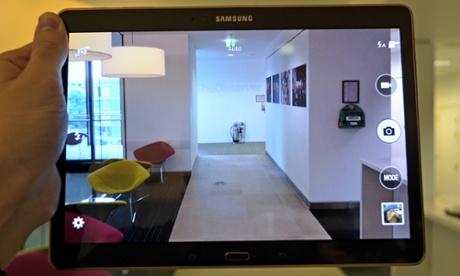 The Tab S has one of the better cameras found on a tablet, which would be fine for a few shots, but won’t replace a decent smartphone camera or dedicated point-and-shoot camera. Photograph: Samuel Gibbs/The Guardian
The Tab S has one of the better cameras found on a tablet, which would be fine for a few shots, but won’t replace a decent smartphone camera or dedicated point-and-shoot camera. Photograph: Samuel Gibbs/The Guardian
The back camera is 8 megapixels, the front (for video chats) 2.1 MP. The rear camera is decent enough for a tablet, with quick autofocus and solid colour reproduction, but the low light performance is poor, producing grainy photos.
Fingerprint scanner
As with the Galaxy S5 phone, the home button doubles as a fingerprint scanner for unlocking the device, and authenticating purchases through PayPal.
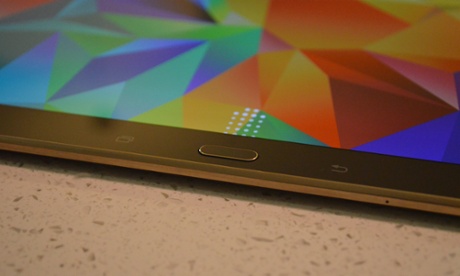 The fingerprint scanner under the home button works fine if you ignore the instructions when first scanning your finger or thumb and scan it in the way you would normally when you unlock the device. Photograph: Samuel Gibbs/The Guardian
The fingerprint scanner under the home button works fine if you ignore the instructions when first scanning your finger or thumb and scan it in the way you would normally when you unlock the device. Photograph: Samuel Gibbs/The Guardian
It is slightly less useful than on the Galaxy S5 because you pick up a tablet in more orientations than a smartphone, and it’ll only register three fingers per user (like the S5).
Premium pricing
Samsung’s Tab S competes directly with Apple’s iPad and is priced accordingly. The Tab S 8.4in Wi-Fi-only version costs £319 and the 10.5in version £399, exactly matching Apple’s pricing. Tab S models with 3G/4G mobile broadband will be available later and cost more.
Verdict: Samsung’s finally cracked it
The Tab S is Samsung’s best tablet yet by miles. Samsung has definitely given the iPad Air and Mini a solid run for their money: these are arguably the best Android tablets to date, with the best screen ever on a tablet. So it will come down to whether you want to use iOS or Android, and whether the “app gap” on tablets matters to you. With Android, though, you’ll have more choice of manufacturer.
Samsung’s Tab S is likely to cost less than its £399/£319 asking price as shops discount it, while the iPad will stick at £399, so that may play a role in the future.
Pros: stunning screen, thin, light, long battery life, powerful processor, fingerprint scanner
Cons: Samsung software can be annoying, lack of quality Android tablet apps
Source: Theguadian


Comments